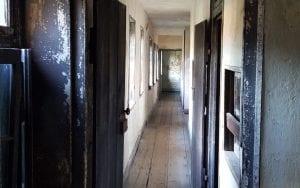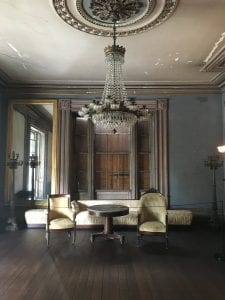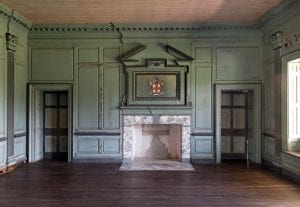Empty Rooms and Layers of Paint: The Beauty of Preserve-As-Found
During our time in Charleston, WPAMC ‘19 visited two historic houses with “preserve-as-found” missions. This model of historic preservation means that an institution works to keep its structures as close as possible to their condition at the time the institution first received them. Rather than attempting to restore interiors to a pristine “original” state, house museums with this model maintain them as they are.
The Aiken-Rhett House is a classic Federal Charleston townhouse with a double balcony and a walled backyard service area where the property’s original slave quarters remain intact. Inside the main house, the walls of the graciously large and high-ceilinged rooms are covered in different layers of peeled paint and wallpaper. The furniture is sparse, the pieces in various states of aging. There is a stark elegance and mystery to these rooms, and because these spaces are being preserved as found, they contain layers and layers of material information.

A view of the second-floor corridor of the slave dwelling at Aiken-Rhett House. Image courtesy of The Slave Dwelling Project.
The power of this as-found material richness is perhaps most clear, however, in the site’s slave dwellings, where recent archaeological work and paint analysis have revealed new information about the lives of generations of inhabitants, including not only enslaved people of the early nineteenth century, but also residents as late as the mid-twentieth century: one of the rooms still has some mid-century green paint on one of its walls.
Many visitors recognize the haunting beauty of spaces like Drayton and Aiken-Rhett, whose empty rooms and peeling layers provide a kind of collaged backdrop against which we may imagine the many different time periods that have taken place within them. Perhaps most inspiring about the preserve-as-found philosophy, though, is the way in which these ongoing efforts acknowledge and accept change, recognizing that no structure can ever be returned to its original state and that all the years of a building’s life leave valuable material evidence. This type of preservation saves the past while gesturing to the future, preserving old spaces while also leaving them open for new interpretation, new stories, new understandings of the past and new generations. By Kate Budzyn, WPAMC Class of 2019




I don’t get it. I just don’t get it. I really appreciate preservation. I really love older architecture. But I don’t get this. I went to a fundraiser for one of these and I’m not sure why they need them.
I understand there would still be utilities and structural repair so people can just walk through it. But I don’t get it